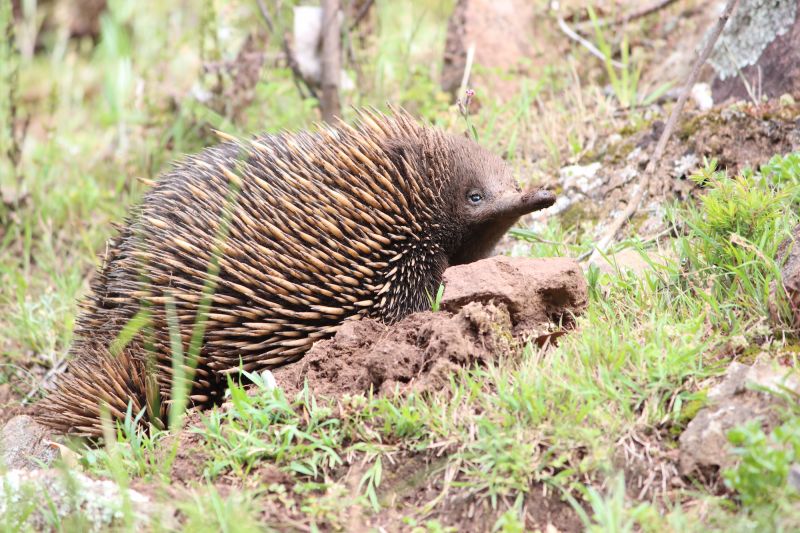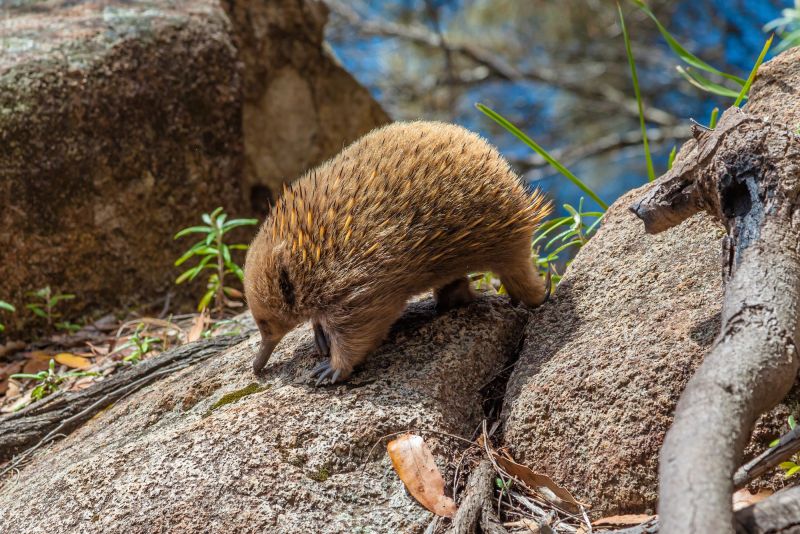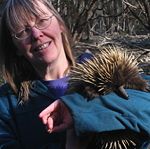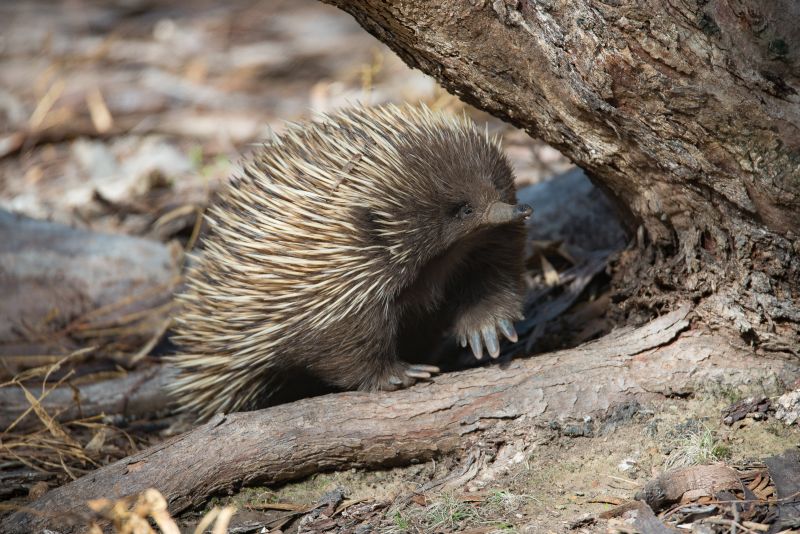The Short-beaked Echidna (Tachyglossus aculeatus) is one of Earth’s oldest mammals, believed to have shared Earth with the dinosaurs, up to 110 Million years ago! The Short-beaked Echidna, Long-beaked Echidna (Zaglossus) and Platypus (Ornithorhynchus anatinus), make up the only three monotremes. Monotremes are egg-laying mammals which, similar to birds and reptiles, have a single waste and reproductive vent.
The Short-beaked Echidna is Australia’s most widespread native animal, with five known sub-species found in different regions of Australia and parts of Papua New Guinea.
- Tachyglossus aculeatus acanthion - found in Northern and Western Australia, ‘acanthion’ refers to its shorter snout.
- Tachyglossus aculeatus aculeatus - found in most of Queensland, New South Wales, Victoria and South Australia.
Tachyglossus aculeatus lawesii - found in Papua New Guinea and possibly north-eastern Queensland. - Tachyglossus aculeatus multiaculeatus - found on Kangaroo Island, ‘multiaculeatus’ refers to the ‘many spikes’ of this sub-species.
- Tachyglossus aculeatus setosus - found in Tasmania and some Bass Strait islands, ‘setosus’ refers to longer fur which blends in with the spines.
 Tachyglossus aculeatus aculeatus - found in Queensland, New South Wales, Victoria and South Australia.
Tachyglossus aculeatus aculeatus - found in Queensland, New South Wales, Victoria and South Australia.
When feeding, the tongue can protrude 18cm from the tip of the snout, lapping up ants, termites and other insects at a rate of over 100 ‘flicks’ per minute - in fact the Genus meaning refers directly to this: “tachy” meaning fast (think tachometer for measuring engine speed or tachycardia for an accelerated heart rate) and “glossus” meaning tongue.
The Short-beaked Echidna is generally solitary, with exception to breeding time. Females emit a powerful perfume called a pheromone which attracts up to 10 males (although 3-5 is more common) which follow the female in a procession called an Echidna train. These trains can last for days and eventually, in a test of patience and resilience, the last remaining male then mates with the female. 22 days after mating, single egg is laid directly into the pouch and hatches 10 days later. When born, the young is the size of a jelly-bean.
Echidna’s do not have a permanent pouch - it is a temporary structure formed by a contraction of the abdominal muscles. Interestingly, both males and females can create this pocket on their belly - this lead to an early over-estimation of female numbers in the population. The young are carried in the pouch for approximately 45 days, suckling from an area of modified hairs on the belly known as the ‘milk patch’. Fast-growing young become too awkward for the mother to carry, so she digs a nursery burrow in the ground. The mother will leave for up to 5 days before returning to feed again. At weaning, the mother will stop returning to the burrow, leaving the young to rely on instinct for life skills and importantly, survival. Tachyclossus aculeates setosus - Short-beaked Echidna found in Tasmania and adjacent islands.
Tachyclossus aculeates setosus - Short-beaked Echidna found in Tasmania and adjacent islands.
Wildlife expert and Kangaroo Island resident Peggy Rismiller has been studying this species for over 50 years. She continues to track and observe the individual she named “Big Mama”, which she has done for most of that time, so we are still yet to fully understand the maximum lifespan.
Where can I see this species with a researcher?
Behind the Scenes with Researchers: Echidnas

Dr Peggy Rismiller (OAM) is an Environmental Physiologist, Educator, Author and Artist along with being the principal (with her partner Mike McKelvey), at a privately-funded off-grid environmental research hub called the Pelican Lagoon Research and Wildlife Centre.
Here she pursues interests in environmental physiology, circadian rhythms, body temperature regulation, reproductive physiology and ecology. Although conducting her early research on reptiles, she is best known for her work with the Short-beaked Echidna, a species which, despite her best efforts, is still quite poorly understood.
This privately organised 'behind the scenes' tour provides special access to the vital research projects being undertaken at Pelican Lagoon Research and Wildlife Centre.
The Echidna is an extremely adaptive creature, able to survive in snowy conditions through to the harsh arid deserts. They have a core body temperature of between 30-32ºC (86-90ºF), but can manipulate it to drop as low as 5ºC (41ºF) in a form of hibernation, where they lower their heart rate to less than one beat per minute!
 Tachyglossus aculeautus multiaculeatus - Kangaroo Island sub-species of Short-beaked Echidna
Tachyglossus aculeautus multiaculeatus - Kangaroo Island sub-species of Short-beaked Echidna
FAQs
Q: Do Echidnas shoot their quills, similar to porcupines?
A: No, the Short-beaked Echidna is very much a passive creature. If it feels intimidated, it will either dig straight down into the earth - their front feet face forwards and back feet face backwards making this vertical escape possible, or curl into a ball, protecting its soft underbody from the attacker with a 360 degree ball of quills.
Q: What is the best time of year to view the Echidna?
A: In cooler regions between September and May (Spring and Autumn). As Winter approaches, they begin to enter periods of hibernation because of their falling low body temperature. Breeding season is usually Spring, when the weather starts to warm up. In the warmer regions they are more likely to be seen in the cooler times than in the heat - all of this is a reflection of a body temperature range and regulation system more akin to reptilian than normal mammalian function.
Q: How long do echidnas live?
A: They have been documented living over 50 years in captivity and at least one record of 45+ years in the wild has been reported. Their average life expectancy is unknown - as it is difficult to identify individuals and time-consuming following a population for that long! Dr Peggy Rismiller has been following a population on Kangaroo Island for 30 years and hopes she lives long enough to answer this question.
Q: How many teeth do they have?
A: None! Their long sticky tongue is used to grind food against hard ridges on their palate and the amount of dirt ingested with their food probably aids in the grinding process.
Where can I see this species?
The Short-beaked Echidna is found across most parts of Australia, however best viewing is with the following operators:


